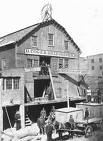
Hunting Sherrill M.D. (3 April 1783 – 16 January 1866) was an American orthodox physician who converted to homeopathy. Sherrill practiced in Hyde Park and Poughkeepsie, and later New York City, at 513 Hudson Street. He served as the President of the Dutchess Medical Society, and was a member of the Homoeopathic Society of New York.
Hunting Sherill was born in Stanford, Duchess County, New York, on 3 April 1783, the son of farmer Jeremiah Sherill (1750 – 1827) and Ruth Hunting (1754 – 1817).
Ill-health prevented Sherrill following his father into farming. Instead, he studied medicine and attended medical lectures in New York City, and under the tutelage of a Dr. Gager of Sharon, Connecticut.
Sherrill was appointed as a physician to the New York almshouse. In January 1809, he was awarded a diploma, signed by Drs. William J. MacNeven, David Hosack, and future homeopath Felix Pascalis, attesting to his medical skill and ability.
In December of the same year, Sherrill moved to Hyde Park, where he soon built up a thriving practice, and that month the New York Medical Society conferred on him the title of Doctor Of Medicine. In 1825, Sherrill was awarded an honorary M.D. by the Geneva Medical College.
In 1811, Sherrill married Margaret Mulford (1792 – 1870) in Staatsburg. They would have ten children together.
By 1832, after twenty three years in Hyde Park, Sherrill moved his practice to Poughkeepsie. There he found himself in the center of a major cholera outbreak that ran from 1832 – 1834.
In addition to his longstanding medical practice, Sherrill found time to write a number of books, including a domestic homeopathy primer. Sherrill also contributed cases to medical journals, including an account of a surgical trepanation he conducted on a patient with a cranial fracture in 1835.
It is not clear when, or how, Sherrill came to homeopathy but, in 1846, he became a member of the American Institute of Homeopathy.
In April 1851, Sherrill read case notes on bronchitis that he had treated homeopathically to the Hahnemann Academy of Medicine, in New York. Two years later, in June 1853, he submitted a brief account of another case to the American Journal of Homeopathy in which he describes a successful homeopathic treatment he gave to a sick railroad conductor, prescribing first Aconite, and subsequently Phosphorus.
At the sixteenth annual meeting of the The American Institute of Homeopathy, held in Boston in June 1859, Sherrill was one of two dozen homeopaths who signed a letter to the Association, cautioning against the growing number of “eclectics” and “empyrics” who were posing as homeopaths, and called for the Association to ensure that a purely homeopathic journal received its support. In response, Henry Mitchell Smith, editor of the American Homoeopathic Review, observed that his journal had been established, as requested by homeopaths, as a more strictly homeopathic publication.
After eight years in Poughkeepsie, in 1840, Sherrill moved down to New York City, where he continued to practice for another twenty-six years, until his death in 1866, aged 82. Hunting Sherrill was interred in Poughkeepsie Rural Cemetery, Duchess County, New York.
Select Publications:
- An Essay on Epidemics, as they Appeared in Dutchess County, From 1809 to 1825. Also a Paper on Diseases of the Jaw-Bones; With an Appendix, Containing an Account of the Epidemic Cholera as it Appeared in Poughkeepsie in 1832 (1832)
- A Manual of Homoeopathic Prescriptions, With a Full and Improved Repertory, in Which Diseases are Alphabetically Arranged, With the Remedy for them Connected (1845)
- A Treatise on Homoeopathic Practice of Medicine: Comprised in a Repertory for Prescribing, Adapted to Domestic or Professional Use (1845)
- A Temperance Medical Lecture on the Injurious and Dangerous Effects of Stimulants and Alcohol (1859)
- Family Physician, or Homoeopathic Practice of Medicine, Adapted to Domestic and Professional Use (1860)


Leave A Comment